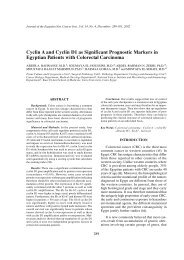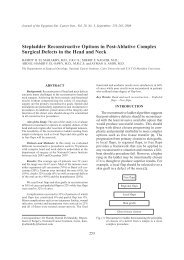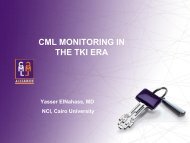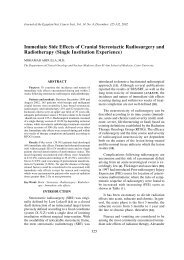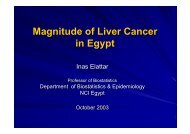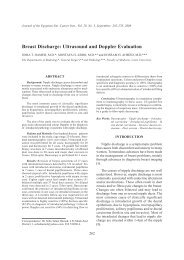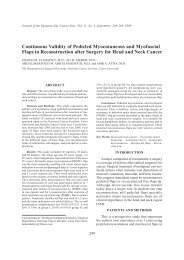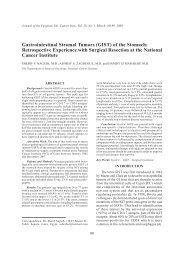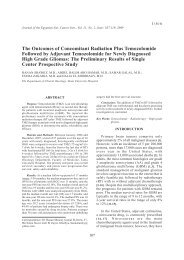Limb Sparing Surgical Resection of Groin Sarcoma. Surgical ... - NCI
Limb Sparing Surgical Resection of Groin Sarcoma. Surgical ... - NCI
Limb Sparing Surgical Resection of Groin Sarcoma. Surgical ... - NCI
You also want an ePaper? Increase the reach of your titles
YUMPU automatically turns print PDFs into web optimized ePapers that Google loves.
282A high percentage <strong>of</strong> patients having groinsarcoma presents to <strong>NCI</strong> Cairo University withsome sort <strong>of</strong> improper management in the form<strong>of</strong> improper long transverse incision for biopsyor trial <strong>of</strong> resection, incomplete excision withgross residual disease left, usually near thepubic bone, around femoral vessels or a missedintrapelvic component. Some cases may havea recurrent disease after previous surgery withor without radiotherapy and need salvage surgery.Patients may be referred for primary radiotherapyby inexperienced surgeons in nonspecialized centers [5].The aim <strong>of</strong> this study is to evaluate thefeasibility <strong>of</strong> limb sparing surgical resectionand reconstructive options in 14 patients havinggroin s<strong>of</strong>t tissue sarcoma; most <strong>of</strong> them weresubjected to improper management before presentationto <strong>NCI</strong>, Cairo University. Oncologicoutcome and functional results <strong>of</strong> those patientsare also reported.MATERIAL AND METHODSThis study was conducted in the NationalCancer Institute, Cairo University during theperiod from January 2001 to December 2006and included 14 patients having s<strong>of</strong>t tissuesarcoma <strong>of</strong> the groin.Preoperative clinical evaluation included amedical history <strong>of</strong> previous surgery or radiotherapyand a physical examination with assessment<strong>of</strong> distal pulsation <strong>of</strong> the popliteal andtibial vessels and femoral nerve function. Presenceor absence <strong>of</strong> distal edema was determinedby visual inspection and by determining indentation<strong>of</strong> the pretibial skin. The presence <strong>of</strong>edema warrants preoperative Doppler ultrasonographyto assess patency <strong>of</strong> the ile<strong>of</strong>emoralvein. Preoperative edema was seen in two casesand duplex showed no thrombosis <strong>of</strong> femoralvein.Preoperative staging studies included plainradiograph to the pelvic bone, CT and MRI withcontrast to assess local extension <strong>of</strong> the tumorespecially intrapelvic extension, the relation <strong>of</strong>the tumor to the ile<strong>of</strong>emoral vessels whetherdisplaced or surrounded by the tumor. Duplexassesses the patency <strong>of</strong> the lumen <strong>of</strong> vessels.MRA and conventional or CT angiography weredone to assess vascular involvement. Chest CTscan was done routinely to all patients to exclude<strong>Limb</strong> <strong>Sparing</strong> <strong>Surgical</strong> <strong>Resection</strong> <strong>of</strong> <strong>Groin</strong> <strong>Sarcoma</strong>pulmonary metastasis. Vascular involvementwas diagnosed when MRI or CT imaging didnot show a rim <strong>of</strong> normal tissue in the tumorto-vessel interface (Figs. 1-4).One patient had extensive pulmonary metastasesand was excluded from the study. Anotherpatient had single pulmonary nodule andwas included in the study. He was subjected tolimb sparing surgery and metastatectomy. Radiologicalvascular involvement was seen in 2cases who were subjected to salvage procedure.One patient had extensive recurrent diseasewith extensive involvement <strong>of</strong> the bony pelvisand ili<strong>of</strong>emoral vessels that necessitate externalhemipelvectomy and was subjected to externalhemipelvectomy and excluded from the study.Finally the salvage procedure was done in 14cases.According to the Enneking staging system[6], 9 patients had stage II, 4 had stage IIA andone patient had stage III. Six cases had variabledegrees <strong>of</strong> intraapelvic extension through theobturator foramen.Histopathological study was done throughrevision <strong>of</strong> previous pathology reports for caseswhich received any type <strong>of</strong> surgery or biopsybefore referral to us (no. 11 cases). Tru-cutneedle, or core biopsy was done for new cases(4 cases). The histological types encounteredwere synovial sarcoma (2 cases), malignantfibrohistiocytoma (4 cases), fibrosarcoma (6cases), hemangiopericytoma (1 case) and liposarcoma(1 case).The extent <strong>of</strong> surgical technique, complicationsand functional results <strong>of</strong> limb-salvagesurgery compared with amputation were discussedwith the patients and consent for operationwas signed in.Tumor resection:Primary tumors without skin involvementand with minimal intrapelvic extension wereapproached through a modified radical groinincision [4]. If groin sarcoma has large extensioninto the pelvis it was preferred to be approachedthrough abdominoinguinal incision that allowsintraabdominal exploration with better exposure<strong>of</strong> pelvic structures [7]. In patients who havesome sort <strong>of</strong> previous management or recurrentcases, the incision was modified accordinglyto include the previous scar or the skin over the
Magdy El-Sherbiny 285tivity, emotional acceptance, need to externalsupport, walking ability and gait. A score <strong>of</strong>five indicates normality and a score <strong>of</strong> oneindicates significant disability. A middle score<strong>of</strong> three would suggest problems such as theneed for non narcotic analgesics, being unableto play sports, the occasional need for a walkingdistant stick and a modest limp. A percentagescore can be given to each factor.Adjuvant therapy: Thirteen patients out <strong>of</strong>14 received postoperative adjuvant radiotherapyafter complete healing <strong>of</strong> the wound. One patienthad preoperative radiotherapy so postoperativeradiotherapy was ignored. One patient havingone pulmonary nodule and 3 patients havinglarge size and high grade were referred forpostoperative chemotherapy.RESULTSPatient details:During the period between 2002 and 2006,we treated and followed 14 patients having s<strong>of</strong>ttissue sarcoma <strong>of</strong> the groin by limb sparingsurgery. The mean age at diagnosis was 39-years (range 28-55 years). Eight patients weremales and 6 were female. The mean follow-uptime was 31 months (range 25-53 months).Ten cases had a primary groin sarcoma;eight <strong>of</strong> them had long transverse incision eitherfor biopsy or trial <strong>of</strong> resection, one <strong>of</strong> thoseeight patients had been treated primarily byradiotherapy and two patients had small transversebiopsy incision. The last four patients hadincomplete resection with gross residual diseaseleft.Approach: The incision was modified accordingto the direction and length <strong>of</strong> the previousscars. Finally, 11 cases were approachedretroperitoneally through modified inguinalapproach and 3 were approached intraabdominallythrough abdominoinguinal approach.Six cases had variable degrees <strong>of</strong> intrapelvicextension <strong>of</strong> their tumors; four <strong>of</strong> them wereresected completely through retroperitonealmodified inguinal approach.<strong>Surgical</strong> margins: According to the histopathologicalreports, wide resection in 9 patients,close but negative margins in 4 patients andpositive microscopical lateral margin in onepatient. Histopathologic examination <strong>of</strong> thespecimens with vascular resection revealed thattwo cases, showed infilteration <strong>of</strong> the bloodvessels.The spermatic cord was dissected in theinguinal canal in all male patients and no patientrequired resection <strong>of</strong> the spermatic cord.The femoral nerve was scarified in threepatients. All patients required sacrifiying <strong>of</strong>some branches <strong>of</strong> the nerve.Bone resection included the superior pubicramus in 7 cases, superior pubic ramus andpubic bone in 5 cases (Fig. 12), superior pubicramus, inferior pubic ramus and pubic bone in2 cases. Part <strong>of</strong> the ro<strong>of</strong> <strong>of</strong> acetablum wasremoved in one case having superior pubicramus resection. The part resected was reconstructedby a double layer <strong>of</strong> dacron graft andproline mesh.Vascular resection and reconstruction: Twocases had femoral vessels involvement and theirtumors were resected en bloc with involvedvessels without amputation. One case requiredprosthetic graft replacement <strong>of</strong> both femoralvein and artery and one case required prostheticgraft replacement <strong>of</strong> femoral vein only.Vascular graft function: After a mean followupperiod <strong>of</strong> 5 months, one case developedocclusion <strong>of</strong> the femoral artery graft. No revisionwas done despite absence <strong>of</strong> distal pulsationbecause the capillary circulation was good andthe patient had no complaint. The two venousgrafts showed graft obstruction however nointerference was done due to absence <strong>of</strong> distaledema.Healing <strong>of</strong> the modified inguinal incision(1 case) or abdominoinguinal incision (1 case)generally healed well without any complications(Fig. 13).Skin coverage: Ten cases required localmyocutaneous flaps for coverage <strong>of</strong> associatedskin loss. Defect size ranged from 15 to 25cmin length and 8 to 16cm in width. Local pedicledflaps used included, gracilis myocutaneous flapin two cases, inferiorly based rectus abdominsmyocutaneous flap in 5 cases (three ipsilateraland 2 contralateral), tensor fascia lata flap inone case and anterolateral thigh flap in onecase. Inferiorly based rectus abdomins muscle
286flap without skin was used in 2 cases (Fig. 14).Sartorius muscle flap was used in 8 patients asit was included with the resection in 6 patients(Fig. 10).We had no flap failure or partial necrosis inall the flaps used.Complications:1- Seroma was the most frequent early complications(incidence 100%). The daily drainoutput ranged from 700 to 1900ml/day. Thiswas managed by prolonged drainage for 2weeks.2- Superficial stitch gaping occurred in 3 caseswhich healed completely within 2 weekswith repeated dressing.3- Wound breakdown and deep infection withexposure <strong>of</strong> the part <strong>of</strong> the underlying abdominalmesh was seen in one case (7%).This patient had previous radiotherapy andwas treated by removal <strong>of</strong> the mesh and thewound was left opened to granulate.4- Lymphedema. The most frequent late complication(35%) and was controlled by legelevation, massage and compression. It wasmild to moderate with no interference withwalking or climbing stairs.<strong>Limb</strong> salvage and limb function results:Over the 5 years study period, the extremitysalvage rate for patients present to us was 87.5%and included 14 patients out <strong>of</strong> 16 patients.<strong>Limb</strong> sparing radical resection was considered<strong>Limb</strong> <strong>Sparing</strong> <strong>Surgical</strong> <strong>Resection</strong> <strong>of</strong> <strong>Groin</strong> <strong>Sarcoma</strong>successful if the patients did not require amputationand have a functioning limb and the tumorwas resected without a residual. Removal <strong>of</strong>the pubic bone does not appear to have any longterm effects in ambulation. According to theMSTS function score, all patients achieved ahigh functional score ranging from 92% to 97%.Tumor control and survival: One patientrequired external hemipelvectomy after 23months postoperatively because <strong>of</strong> extensivelocal recurrence in the proximal thigh. The 2year local tumor control rate <strong>of</strong> those patients(minimal follow-up period) was 92.8% for 13/14patients. Two patients died because <strong>of</strong> extensivepulmonary metastasis after 24 and 26 months<strong>of</strong> surgery. The 2 year survival rate, the minimalfollow-up period, was 85.7% for 12/14 patients.Fig. (1): T1 MRI, showing the proximal extension <strong>of</strong> groins<strong>of</strong>t tissue sarcoma.Fig. (2): T1 MRI, showing the proximalextension <strong>of</strong> groin s<strong>of</strong>t tissuesarcoma.Fig. (3): T2 MRI, showing intrapelvicextension <strong>of</strong> groin sarcoma.Fig. (4): Preoperative angiographyshowing involvement <strong>of</strong> superfacialfemoral artery.
Magdy El-Sherbiny 287Fig. (5): Improper transverse incision with incompleteresection.Fig. (6): Defect after resection <strong>of</strong> groin sarcoma.Note, femoral vessels, spermatic cordand proline mesh for reconstruction <strong>of</strong>abdominal wall defect.Fig. (7): Rectus abdomins myocutaneous flap for coverage <strong>of</strong> longitudinalgroin and thigh defect after resection <strong>of</strong> groin s<strong>of</strong>ttissue sarcoma.Fig. (8): Rectus abdomins myocutaneous flapfor coverage <strong>of</strong> transverse defect afterresection <strong>of</strong> groin s<strong>of</strong>t tissue sarcoma.Fig. (9): Gracilis myocutaneous flap for reconstruction <strong>of</strong>groin defect after resection <strong>of</strong> groin s<strong>of</strong>t tissuesarcoma.Fig. (10): Gracilis myocutaneous flap for reconstruction<strong>of</strong> groin defect after resection<strong>of</strong> groin s<strong>of</strong> tissue sarcoma.
288<strong>Limb</strong> <strong>Sparing</strong> <strong>Surgical</strong> <strong>Resection</strong> <strong>of</strong> <strong>Groin</strong> <strong>Sarcoma</strong>Fig. (11): Tensor fascia lata flap for reconstruction <strong>of</strong>large transverse groin defect after resection <strong>of</strong>groin s<strong>of</strong>t tissue sarcoma.Fig. (12): Postoperative plain X-ray, showing resection<strong>of</strong> pubic bone and superior puboc ramius.Fig. (13): Healing <strong>of</strong> abdominoinguinal incisionafter resection <strong>of</strong> groin s<strong>of</strong>t tissuesarcoma with pelvic extension.Fig. (14): Inferior rectus muscle flap without skin for coverage<strong>of</strong> femoral vascular graft and proline mesh.DISCUSSIONThe rationale <strong>of</strong> limb sparing surgical resectionfor s<strong>of</strong>t tissue sarcoma includes improvement<strong>of</strong> survival, achievement <strong>of</strong> adequate negativesafety margins around the tumor tomaximize local control, adequate s<strong>of</strong>t tissuecoverage <strong>of</strong> implants and deep structures witha reliable myocutaneous flap [9-13].<strong>Limb</strong> sparing surgical resection <strong>of</strong> groinsarcoma is different from that <strong>of</strong> anterior thighdue to proximity to the pubic bone with possibleintrapelvic extension and close relation to thefemoral vessels. Wound problems may occurwith minimal skin excision or even followingsimple elevation <strong>of</strong> skin flaps. Safe resectionwith achievement <strong>of</strong> clear margins entails theneed <strong>of</strong> wide retroperitoneal or intraabdoimalexploration through modified inguinal or abdominoinguinalincisions, exposure and control<strong>of</strong> ili<strong>of</strong>emoral vessels proximally and distallyand resection <strong>of</strong> the pubic bone. Also, good
Magdy El-Sherbiny 289orientation with the reconstructive options isneeded [2,3,4].Mismanagement in the form <strong>of</strong> improperbiopsy incision or incomplete resection or localrecurrence with skin involvement will add tothe difficulty to the proper approach. In thepresent study, the skin incision was modifiedin 85.7% <strong>of</strong> cases to include previous scars orareas <strong>of</strong> possibly infiltrated skin and then theapproach was continued as previously describedmodified inguinal or abdominoinguinal approach[4,7]. Through this approach, we wereable to resect the tumor with negative marginsin 12/14 <strong>of</strong> cases (92.8%). Only one case (7%)had single microscopic positive margin. Thismight be due to previous radiotherapy and theresulting dense fibrosis that may add difficultyto the proper intraaoperative assessment <strong>of</strong> themargins.Vascular resection and prosthetic reconstructionwas done in two cases. S<strong>of</strong>t tissue sarcomasinvolving major vascular structures are notconsidered a contraindication <strong>of</strong> limb sparingsurgery. Patients can undergo vascular resectionwhen the tumor is infiltrating or encasing thevessels [14,15]. Schwarzbach et al. [16], recommendedsynthetic grafts for arterial and venousvascular substitute in the ili<strong>of</strong>emoral region.The rational <strong>of</strong> this is to reduce the operativetime and to preserve the great saphenous vein(GSV) and usually there is some degree <strong>of</strong>caliber discrepancy between ili<strong>of</strong>emoral andGSV.Reconstruction <strong>of</strong> resected ili<strong>of</strong>emoral veinis mandatory. This prevents limb edema in theimmediate postoperative period and associatedclinical sequale as complicated wound healing,pain, edema, tension and skin alteration. Femoralvein resection distal to the entry <strong>of</strong> the ipsilateralGSV can be ligated if GSV was preserved andwas patent, however, some recommended autologousvein graft for fear <strong>of</strong> infection <strong>of</strong>prosthetic grafts [16].When a prosthetic vascular raft has beenused to replace the femoral vessels, an effortshould be made to cover the graft at the end <strong>of</strong>the procedure with rotation <strong>of</strong> muscle to avoidexposure and infection [16,17,18]. In the 2 caseshaving prothetic vascular graft in the presentstudy, medial transposition <strong>of</strong> sartoius musclewas not enough for complete coverage, so the2 cases had had rectus muscle and mucocutaneousflap coverage.The reported patency rates for prostheticvenous reconstructions are lower than for arterialones; however, the use <strong>of</strong> the autologous veinhas not proven to be superior to synthetic graftswith respect to the long-term patency rate afterlimb-salvage surgery [16,19,20]. In the presentstudy, one case had concomitant venous andarterial prosthetic reconstruction and one hadonly venous prothetic reconstruction. All the 3grafts lost patency within 5 months postoperativelydespite anticoagulant therapy. Usuallyrevision is not needed for venous reconstructionas usually by time collaterals develop. Revision<strong>of</strong> arterial graft may be considered however, inthe present study revision was ignored as thepatient had no complaint and distal circulationwas very good.Involvement <strong>of</strong> the femoral nerve in threecases (21%) necessitated nerve sacrifice. Most<strong>of</strong> tumors in the present study were medial tothe femoral vessels so the nerve could be sparedin most cases. The residual function <strong>of</strong> postnerve resection was frequently very good. Thosepatients only need a temporary knee brace [7].Microvascular free flap transfer is rarelyrequired to cover groin defects. This is due toavailability <strong>of</strong> some reliable local muscle andmusculocutaneous flaps. Local flaps reportedfor groin defect reconstruction included tensorfacia lata flap [21], anterolateral thigh flap [22],inferiorally based rectus abdomins myocutaneousflap [23], gracilis myocutaneous [24], Sartoriusmuscle flap [25] and rectus femoris muscleand musculocutaneous flap [26].A total <strong>of</strong> number <strong>of</strong> 10 myocutaneous flapswere used in the present study. We had no flapfailure or partial necrosis. To minimize the risk<strong>of</strong> failure, the selection between the availableflaps in the present study was finalized aftercompletion <strong>of</strong> the process <strong>of</strong> resection and wasbased on many factors such as the site <strong>of</strong> thedefect (lateral or medial part <strong>of</strong> the groin), size<strong>of</strong> the defect, orientation <strong>of</strong> the axis <strong>of</strong> the defectand which branches <strong>of</strong> the ili<strong>of</strong>emoral vesselwere preserved such as the pr<strong>of</strong>unda artery andits branches and the inferior epigastric artery.Inferiorly based rectus abdomins myocutaneousflap has a pedicle length ranging from 7-
29012cm which is the inferior epigastric artery.This allows a wide arc <strong>of</strong> rotation when usedas a pedicled flap [23]. This wide arc <strong>of</strong> rotationallows easy usage <strong>of</strong> either the right or leftrectus muscle. Adding to the possibility <strong>of</strong>harvesting the skin island in a transverse or avertical direction, over its proximal or its distalpart are the main factors behind selection <strong>of</strong>this flap in most patients in the present studyso as to fit most <strong>of</strong> the previously unplannedskin defects in our patients. We prefer the ipsilateralone except if the ipsilateral inferiorepigastric artery is ligated. The main disadvantage<strong>of</strong> this flap is abdominal wall weakness soabdominal wall reconstruction by a prolinemesh was mandatory.Tensor fascia lata flap is a my<strong>of</strong>asciocutaneousflap based on the transverse branch <strong>of</strong>the lateral circumflex femoral artery [21,27,28].We had one case <strong>of</strong> tensor facia lata flap. A skinisland <strong>of</strong> 12cm in width and 23cm in lengthwas elevated. The main disadvantage was creation<strong>of</strong> dog ear and the need to graft the donorsite. Necrosis <strong>of</strong> distal part has also been reported[27] however; this has been avoided by leavingat least 8cm above the knee joint. Also it isnot suitable for reconstruction <strong>of</strong> longitudinalgroin defects parallel to the longitudinal axis<strong>of</strong> the tensor fascia lata flap that is why we hada limited number <strong>of</strong> patients having this flapreconstruction.The pedicled anteroalteral thigh flap hasbeen used for reconstruction <strong>of</strong> groin, perinealand gental defects [22]. It can be raised as afasciocutaneous or myocutaneous flap (a portion<strong>of</strong> vastus lateralis muscle), it is based on thedescending branch <strong>of</strong> lateral circumflex femoralvessel. The pedicle is long and allows easilymedial rotation. Skin territory <strong>of</strong> the flap is verywide and large (25 x 18cm). Primary closure<strong>of</strong> the donor site is possible when the transverseaxis <strong>of</strong> the defect is less than 8cm [29,30,31]. Wehad one case in the present study having anterolateralthigh flap.<strong>Limb</strong> <strong>Sparing</strong> <strong>Surgical</strong> <strong>Resection</strong> <strong>of</strong> <strong>Groin</strong> <strong>Sarcoma</strong>Gracilis myocutaneous flap is a versatileflap for reconstruction <strong>of</strong> groin, perineal andgental defects [32]. It is based on descendingbranches <strong>of</strong> medial circumflex femoral artery[24]. Skin availability is limited, that is why weused it in only 3 cases in the present studybecause they had little skin defect. It has noadverse effect on adductor muscle group functiondonor site can be closed primary leavingan acceptable scar in the medial aspect <strong>of</strong> thethigh.Rectus femoris muscle and myocutaneousflap has been reported in reconstruction <strong>of</strong> groindefect [26]. It is based on branches from descendingbranch <strong>of</strong> lateral circumflex femoral.However, it is not widely used because it hassignificant knee weakness and there are otherreliable flap, that is why we did not try to useit in the present study.Sartorius muscle has a segmental bloodsupply (Type IV) [25]. It has a thin muscle belly,which is not suitable to cover large defects afterresection <strong>of</strong> groin sarcoma [33]. However, weroutinely used it even in the presence <strong>of</strong> othermuscle flaps to cover femoral vessels unless itis included in the resection. It has been used in57% <strong>of</strong> our cases.Modified inguinal or abdominoinguinal incisionin the 2 cases shown in the present study,generally healed well without any complicationsand without ischemia to the skin edges. Thishas also been also reported by Karakousis [7].This raises the issue that, appropriate biopsymay avoid the need to remove part <strong>of</strong> the skinunless involved by the tumor. In such cases,muscle transfer without skin may be enough tocover vascular prosthesis, mesh or exposedvessels. The only situation where ischemia wasexpected to occur with abdominoinguinal incisionwas in a patient who have already had inthe past a transverse incision in the ipsilaterallower abdominal quadrant and therefore thismay result is a narrow strip <strong>of</strong> skin between theprevious transverse incision and the transverseportion <strong>of</strong> the abdominoinguinal incision whichmay have deficient blood supply. In order toavoid this complication, the transverse portion<strong>of</strong> incision was included passing through theprevious transverse incision and then extendsvertically into the groin area.Seroma formation after groin node dissectionis reported to be high. The drain output fromgroin can be as high as 4000ml per 24h in theearly postoperative days and frequently takes2-3 weeks to decrease [3,34]. The daily amount<strong>of</strong> seroma is markedly lower in the presentseries in comparison with that reported withgroin node dissection and took less time todecrease. The explanation <strong>of</strong> this finding may
Magdy El-Sherbiny 291be related to the retroperitoneal exposure thatmay enhance absorption <strong>of</strong> the resulting seroma.This encouraged us to remove the drains asearly as possible to minimize the incidence <strong>of</strong>deep infection. The drains were removed beforethe end <strong>of</strong> 2 weeks postoperatively in all caseswith no resulting lymphatic fistula or collection.The rate <strong>of</strong> perioperative morbidity must beevaluated in the light <strong>of</strong> the goals <strong>of</strong> limb salvagefor s<strong>of</strong>t tissue sarcoma. Hematoma, deep woundinfection, skin necrosis, local flap sloughingand lymphatic fistulas are the major causes <strong>of</strong>a complicated postoperative course. The use <strong>of</strong>prosthetic material as proline mesh or prostheticvascular graft is considered a possible risk factorfor the development <strong>of</strong> deep wound infection[5,35]. Wound morbidity rate <strong>of</strong> 34.7% has beenreported. Deep wound infection and exposure<strong>of</strong> the proline mesh near the lower part <strong>of</strong> theabdominal wall was seen in one case in thepresent series (7%). This patient received preoperativeradiotherapy which is considered arisk factor. Cautious interpretation, however, ismandatory to minimize the risk <strong>of</strong> wound complications.Aseptic procedural standards, thecorrect placement <strong>of</strong> suction drains, prophylacticadministration <strong>of</strong> antibiotics, Careful hemostasisand use <strong>of</strong> suitable local muscle or musculocutaneousflaps to completely cover deep structuresare behind the low rate <strong>of</strong> complications in thepresent study.Chronic lymphedema is most likely causedby extensive resection <strong>of</strong> lymphatic tissue andextensive fibrosis due to postoperative radiotherapy[3]. Lymphedema may have a vascularcomponent due to loss <strong>of</strong> venous patency aftervenous replacement. On long term follow-up,only 35% <strong>of</strong> our cases developed chroniclymphedema. It is low in comparison with otherauthors [2,16]. This may be explained by development<strong>of</strong> collaterals across myocutaneous flapsused in 71.4% <strong>of</strong> patients. For most patients,the edema occasionally decreases with physiotherapy.Removal <strong>of</strong> the pubic bone and its rami doesnot appear to have any long term effects inambulation [36] however, reconstruction <strong>of</strong> theresulting defect is mandatory to prevent thedevelopment <strong>of</strong> inguinal heria. In one case inaddition <strong>of</strong> resection pubic bone, part <strong>of</strong> theacetabulum was included with the resection.This was reconstructed by a double layer <strong>of</strong>dacron graft and proline mesh. This has notbeen reported however, this may be consideredas, on follow-up, this patient did not have anyhip pain, stiffness or migration <strong>of</strong> the head <strong>of</strong>femur. According to the MSTS function score,all our patients have achieved a high functionalscore ranging from 92% to 97%.The use <strong>of</strong> adjuvant radiation therapy inpatients with limb sparing surgery for extremitySTS has been widely accepted [37,38,39]. Weapply postoperative radiotherapy for extremitys<strong>of</strong>t tissue sarcoma in our institute. Intraoperativeradiotherapy improves local tumor control[40]. However; this type <strong>of</strong> therapy is not availablein our institute. We had no delay in startingradiotherapy in the present study as we had nowound problems in nearly all cases. The onlyone case who had wound breakdown had receivedradiation therapy before salvage surgery.Concerning patient survival and local tumorcontrol, this study had shown that a stagedependentlong-term survival and local tumorcontrol could be achieved. The 2 year survivalrate and local tumor control in those selectivehigh-risk group <strong>of</strong> STS patients, the minimalfollow-up period, was 92.8% and 85.7% respectively.We cannot compare our results with otherreported series [2,41,42] because we need a largernumber <strong>of</strong> patients and a longer follow-up period.Conclusion: Patients having groin sarcomawith some sort <strong>of</strong> improper management maystill have a chance <strong>of</strong> successful limb sparingsurgical resection with a curative intent. Properpreoperative reevaluation <strong>of</strong> extension <strong>of</strong> thetumor and vascular involvement, wide retroperitonealexposure to maximize tumor resectionwith negative margins, vascular replacement ifili<strong>of</strong>emoral vessels are involved and availability<strong>of</strong> local myocutaneous flaps minimizes theproblems <strong>of</strong> wound healing and subsequentinfection. All those factors enable a safe limbsparingresection with stage-dependent oncologiclong-term outcome and good limb functionalresults.Acknowledgment: I would like to thank DrKarim salam for his support during vascularreconstruction in this series. Also, I would liketo thank Dr. Mohamed Rifat and Dr. Wael Samywho allowed us to include one case done bythem in this series.
292REFERENCES1- Brooks AD, Bowne WB, Delgado RD, Leung DY,Woodruff J, Lewis J, Brennan MF. S<strong>of</strong>t tissue sarcomas<strong>of</strong> the groin: Diagnosis, management and prognosis.J Am Coll Surg. 2001, 193: 130-136.2- Reece GP, Gillis TA, Pollock RE. Lower extremitysalvage after radical resection <strong>of</strong> malignant tumors inthe groin and lower abdominal wall. J Am Coll Surg.1997, 185: 260-267.3- Karakousis CP. Exposure and reconstruction in thelower portion <strong>of</strong> the retroperitoneum and abdominalwall. Archives <strong>of</strong> Surgery. 1982, 117: 840-4.4- Koperna T, Teleky B, Vogl S, Windhager R, KainbergerF, Schatz K-D, Kotz R, Polterauer P. Vascular reconstructionfor limb salvage in sarcoma <strong>of</strong> the lowerextremity. Arch Surg. 1996, 131: 1103-7.5- Parkash S. The use <strong>of</strong> myocutaneous flaps in blockdissections <strong>of</strong> the groin in cases with gross skininvolvement. Br J Plast Surg. 1982, 5: 413-9.6- Enneking WF, Spanier SS, Goodman MA. A systemfor the surgical staging <strong>of</strong> musculoskeletal sarcoma.Clin Orthop Relat Res. 1980, 153: 106-113-20.7- Karakousis CP. Abdominoinguinal incision and otherincisions in the resection <strong>of</strong> pelvic tumors. <strong>Surgical</strong>Oncology. 2000, 9: 83-90.8- Enneking WF, Dunham W, Gebhardt MC, MalawerM, Pritchard DJ. A system for functional evaluation<strong>of</strong> reconstructive procedures after surgical treatment<strong>of</strong> tumors <strong>of</strong> the musculoskeletal system. Clin OrthopRelat Res. 1993, 286: 241-6.9- Zagars GK, Ballo MT, Pisters PW, Pollock RE, PatelSR, Benjamin RS. <strong>Surgical</strong> magrins and resection inthe management <strong>of</strong> patients with s<strong>of</strong>t tissue sarcomausing conservative surgery and radiation therapy.Cancer. 2003, 97: 2544-53.10- Brennan M, Alektiar K, Maki R. <strong>Sarcoma</strong>s <strong>of</strong> the s<strong>of</strong>ttissue and bone. In: De Vita V, Hellman S. RosenbergS, editors. Cancer: Principles and practice <strong>of</strong> oncology,Vol. 2. Philadelphia: Lippincott Williams and Wilkins.2001, p. 1841-935.11- Keus RB, Rutgers EJ, Ho GH, Gortzak E, Albus-Lutter CE, Hart AA. <strong>Limb</strong>-sparing therapy <strong>of</strong> extremitys<strong>of</strong>t tissue sarcomas: Treatment outcome and longtermfunctional results. Eur J Cancer. 1994, 30: 1459-63.12- Rosenberg SA, Tepper J, Glatstein E, Costa J, BakerA, Brennan M, DeMoss EV, Seipp C Sindelar WF,Sugarbaker P, Wesley R. The treatment <strong>of</strong> s<strong>of</strong>t-tissuesarcomas <strong>of</strong> the extremities: Prospective randomisedevaluations <strong>of</strong> (1) limb-sparing surgery plus radiationtherapy composed with amputation and (2) the role<strong>of</strong> adjuvant chemotherapy. Ann Surg. 1982, 196: 305-14.13- Geer RJ, Woodruff J, Casper ES, Brennan MF. Management<strong>of</strong> small s<strong>of</strong>t-tissue sarcoma <strong>of</strong> the extremityin adults. Arch Surg. 1992, 127: 1285-9.<strong>Limb</strong> <strong>Sparing</strong> <strong>Surgical</strong> <strong>Resection</strong> <strong>of</strong> <strong>Groin</strong> <strong>Sarcoma</strong>14- Karakousis CP, Karmpaliotis C, Driscoll DL. Majorvessels resection during limb-preserving surgery fors<strong>of</strong>t tissue sarcoma. World J Surg. 1996, 20: 345-50.15- Ceraldi CM, Wang T-N, O’Donnell RJ, McDonaldPT, Granelli SG. Vascular reconstruction in the resection<strong>of</strong> s<strong>of</strong>t tissue sarcoma. Perspect Vasc Surg. 2000,12: 67-83.16- Schwarzbach MHM, Hormann Y, Hinz U, Bernd L,Willeke F, Mechtersheimer G, et al. Results <strong>of</strong> limbsparingsurgery with vascular replacement for s<strong>of</strong>ttissue sarcoma in the lower extremity. J Vasc Surg.2005, 42: 88-97.17- Kawai A, Hashizume H, Inoue H, Uchida H, Sano S.Vascular reconstruction in limb salvage operationsfor s<strong>of</strong>t tissue tumors <strong>of</strong> the extremities. Clin Orthop.1996, 332: 215-22.18- Nishinari K, Wolosker N, Yazbek G, Zerati A, NishimotoI. Venous reconstructions in lower limbs associatedwith resection <strong>of</strong> malignancies. J Vasc Surg.2006, 44: 1046-50.19- Leggon RE, Huber TS, Scarborough MT. <strong>Limb</strong> salvagesurgery with vascular reconstruction. Clin Orthop.2001, 387: 207-16.20- Matsushita M, Kuzuya A, Mano N, Nishikimi N,Sakurai T, Nimura Y, et al. Sequelae after limb-sparingsurgery with major vascular resection for tumor <strong>of</strong>the lower extremity. J Vasc Surg. 2001, 33: 694-9.21- Carlson GW, Hester TR, Coleman JJ. The role <strong>of</strong> thetensor fasciae latae musculocutaneous flaps in abdominalwall reconstruction. Plast Surg Forum. 1988, 11:151-57.22- Kimata Y, Uchiyama K, Ebihara S, Nakatsuka T, HariiK. Anatomic variations and technical problems <strong>of</strong> theanterolateral thigh flap: A report <strong>of</strong> 74 cases. PlastReconstr Surg. 1998, 102: 1517-1523.23- Logan SE, Mathes SJ. The use <strong>of</strong> a rectus abdominismyocutaneous flap to reconstruct a groin defect. BrJ Plast Surg. 1984, 37: 351-3.24- Giordano PA, Abbes M, Pequignot JP. Gracilis bloodsupply: Anaomical and clinical re-evaluation. Br JPlast Surg. 1990, 43: 266-72.25- Yang D, Morris S, Sigurdson L. The sartorius muscle:Anatomic considerations for reconstructive surgeons.Surg Radiol Anat. 1998, 20: 307.26- Caulfield WH, Curtsinger L, Powell G, Pederson WC.Donor leg morbidity after pedicled rectus femorismuscle flap transfer for abdominal wall and pelvicreconstruction. Ann Plast Surg. 1994, 32: 377-82.27- Rifaat M, Wael Sami A. The use <strong>of</strong> tensor fascia latapedicled flap in reconstructing full thickness abdominalwall defects and groin defects following tumor ablation.Journal <strong>of</strong> the Egyptian Nat. Cancer Inst. 2005,Vol. 17, No. 3, September: 139-148.28-Schoeman BJ. The tensor fascia lata myocutaneousflap in reconstruction <strong>of</strong> inguinal skin defects afterradical lymphadenectomy. Safr J Surg. 1995, 33: 175-178.
Magdy El-Sherbiny 29329- Ahmad QG, Reddy M, Shetty KP, Rajendra PrasadJS, Bhathena HM. <strong>Groin</strong> reconstruction by anterolateralthigh flap: A review <strong>of</strong> 16 cases Indian J PlasticSurg January-June. 2004, Vol. 37 Issue 1: 34-39.30- Perirong YU, Sanger JR, Matloub HS, Gosain A,Larson D. Anterolateral thigh fasciocutaneous islandflaps in Perineoscrotal reconstruction. Plast ReconstrSurg. 2002, 109: 610.31- Evriviades D, Raurell A, Perks G. Pedicled anterolateralthigh flap for reconstruction after radical groin dissection.Urology. 2007, 70: 996-999.32- Whetzel TP, Lechtman AN. The gracilis my<strong>of</strong>asciocutaneousflap: Vascular anatomy and clinical application.Plast Reconstr Surg. 1997, 99: 1642-55.33- Meyer JP, Durham JR, Schwarcz TH, Sawchuk AP,Schuler JJ. The use <strong>of</strong> sartorius musclerotation-transferin the management <strong>of</strong> wound complications afterinfrainguinal vein bypass: A report <strong>of</strong> eight cases anddescription <strong>of</strong> the technique. J Vasc Surg. 1989, 9:731.34- Johnson DE, Lo RK. Complications <strong>of</strong> groin dissectionin penile cancer: Experience with 101 lymphadenectomies.Urology. 1984, 24: 312-4.35- Skibber JM, Lotze MT, Seipp CA, Salcedo R, RosenbergSA. <strong>Limb</strong> sparing surgery for s<strong>of</strong>t tissue sarcomas:Wound related morbidity in patients undergoing widelocal excision. Surgery. 1987, 102: 447-52.36- Karakousis CP, Emrich L, Driscoll D. Variants <strong>of</strong>hemipelvectomy and their complications. AmericanJournal <strong>of</strong> Surgery. 1989, 158: 404-8.37- Cheng EY, Dusenbery KE, Winters MR, ThompsonRC. S<strong>of</strong>t tissue sarcomas: Preoperative versus postoperativeradiotherapy. J Surg Oncol. 1996, 61: 90-9.38- O’Sullivan B, Davis AM, Turcotte R, Bell R, CattonC, Chabot P, Wunder J, Kandel R, Goddard K, SaduraA, Pater J, Zee B. Preoperative versus postoperativeradiotherapy in s<strong>of</strong>t-tissue sarcoma <strong>of</strong> the limbs: Arandomised trial. Lancet. 2002, 359: 2235-41.39- Frezza G, Barbieri E, Ammendolia I, Corsa P, Neri S,Putti C, Veraldi A, Babini L. Surgery and radiationtherapy in the treatment <strong>of</strong> s<strong>of</strong>t tissue sarcomas <strong>of</strong>extremities. Ann Oncol. 1992, 3 (Suppl 2): 93-5.40- Van Kampen M, Eble MJ, Lehnert T, Bernd L, JensenK, Hensley F, Krempien R, Wannenmacher M. Correlation<strong>of</strong> intraoperatively irradiated volume andfibrosis in patients with s<strong>of</strong>t-tissue sarcoma <strong>of</strong> theextremities. Int J Radiat Oncol Biol Phys. 2001, 51:94-7.41- Karakousis CP, Karmpaliotis C, Driscoll DL. Majorvessels resection during limb--preserving surgery fors<strong>of</strong>t tissue sarcoma. World J Surg. 1996, 20: 345-50.42- Hohenberger P, Allenberg JR, Schlag PM, ReichardtP. Results <strong>of</strong> surgery and multimodal therapy forpatients with s<strong>of</strong>t tissue sarcoma invading to vascularstructures. Cancer. 1999, 85: 396-408.



